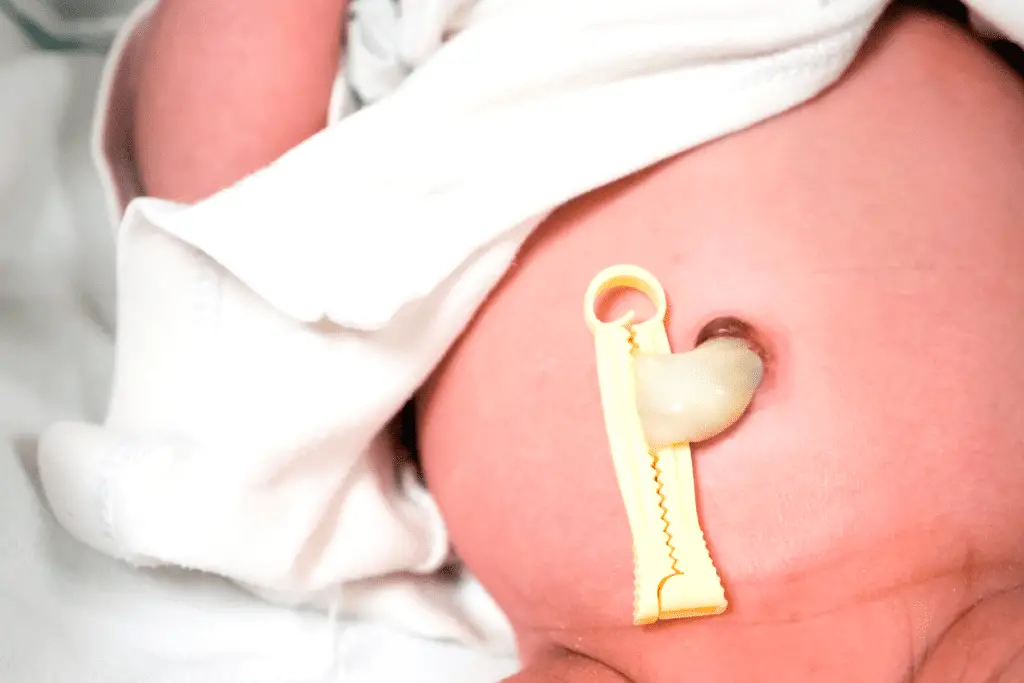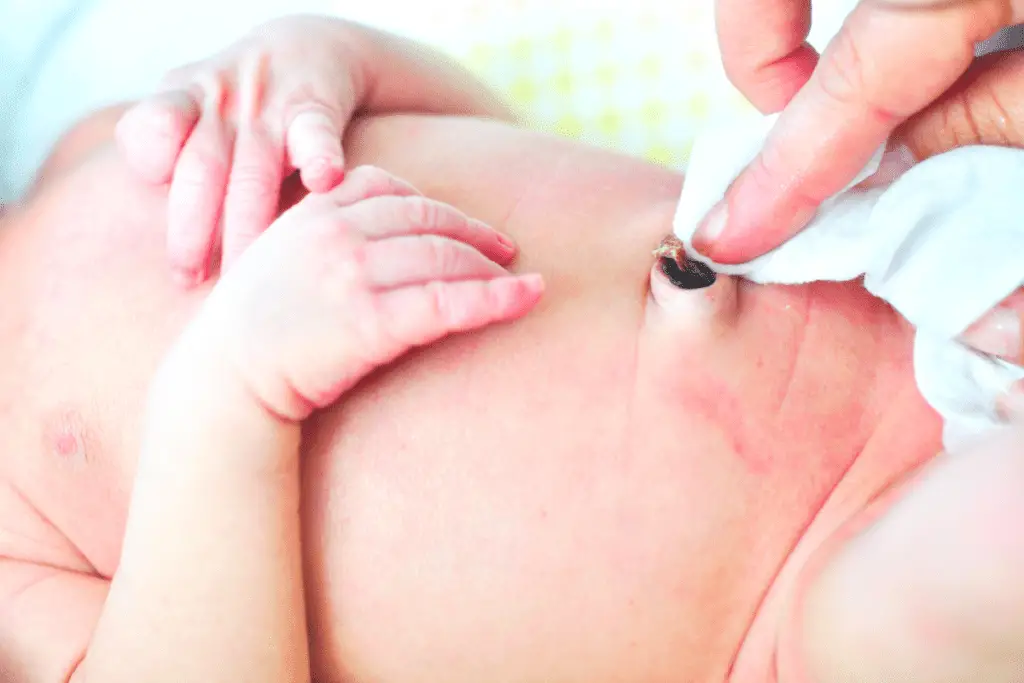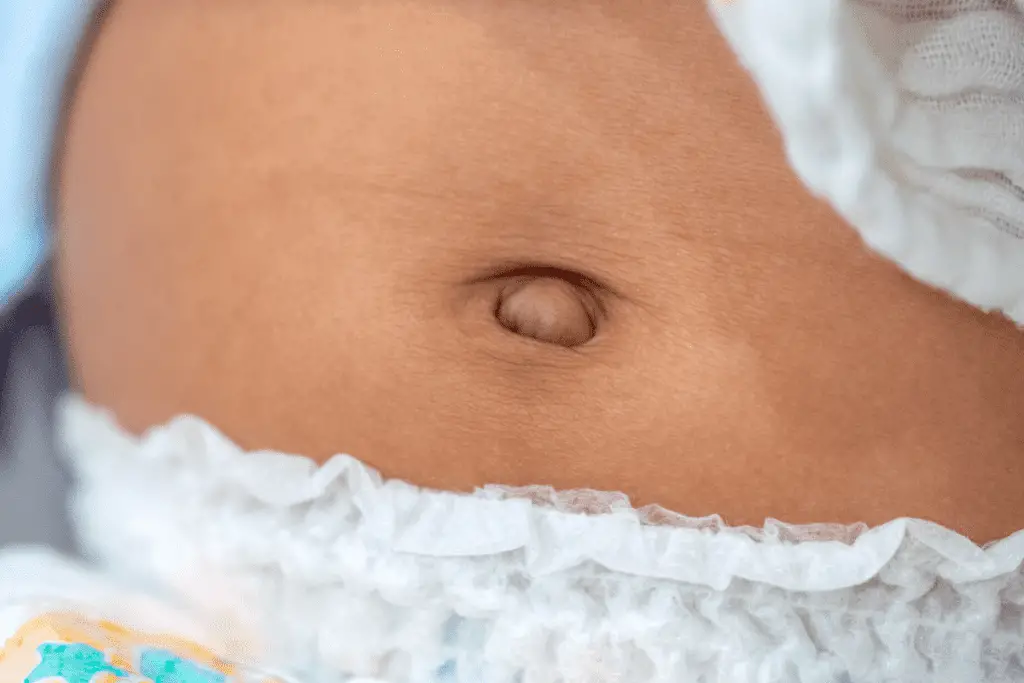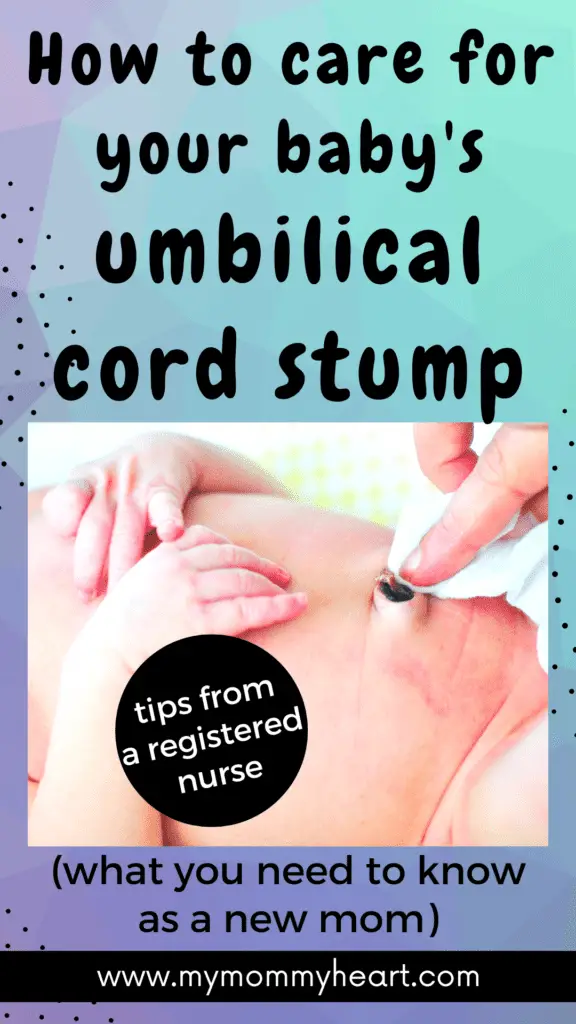For some parents it’s a magical moment after delivery: the cutting of the umbilical cord that has connected you and your newborn for many months. Your baby’s cord will be clamped and cut, leaving a little stump with a plastic clamp in its place. The plastic clamp can usually be removed after a few days, often even before leaving the hospital.
The cord stump will dry out and eventually fall off. It takes about 1-2 weeks for this to happen. What’s left after that is your little one’s belly button.
During the healing period, after cutting and before the stump falls off, all you really have to do is keep it dry and be gentle around it. Old advice said to swab it with alcohol or hydrogen peroxide, but new research suggests just leaving it is best.

What is the umbilical cord stump, and when does it fall off?
The umbilical cord supplies your baby with important nutrients and oxygen during pregnancy. After your little one is born, the umbilical cord is tied off using an umbilical clamp. Don’t worry; you and your baby won’t feel anything because there are no nerves in the umbilical cord.
Once the cord stump has stopped bleeding and has dried, the clamp can be removed. That usually happens within the first 24 to 48 hours. A small stump remains, which dries, shrinks, and hardens over time. Its color also changes from yellow to brownish-black.
The umbilical cord stump then usually falls off after 10-14 days. Contact your midwife or pediatrician if it seems to take longer with your baby. Sometimes, it could be a sign of an infection and must be looked at.
After the stump falls off, the underlying skin will mostly be healed. However, just like a healing wound, it can feel rough or still leak a little liquid. Continue to keep the area dry, and it will soon be healed completely. Contact the midwife if the skin hasn’t healed within 2 weeks of the stump falling off.

How to care for your baby’s umbilical cord stump
1. Always wash your hands
The umbilical stump is a healing wound that could possibly become infected. Before cleaning the area, you should always wash your hands thoroughly to avoid any contamination.
2. Keep it clean and dry
Before the stump falls off, all you really have to do is keep it all clean and dry and be gentle around it. Old advice said to swab it with alcohol or hydrogen peroxide, but new research suggests just leaving it is best, so no care products are needed!
3. Be gentle
Do not attempt to take off the umbilical stump with your fingers by pulling it or plucking. It will fall off all by itself without your intervention when the skin underneath has healed and is ready.
4. Fold your baby’s diaper down
That prevents the diaper from rubbing against the stump. And the area won’t get irritated from urine and other diaper content.
5. Loose clothing
Onesies that are loose on the abdomen are best for letting the area heal undisturbed.
6. Regular checks
It is usually enough to clean the umbilical cord area of a newborn once a day. However, it won’t hurt to look at it more often – for example, every time you change the diaper anyways. If you discover anything dirty around it, simply always clean it immediately.
7. Delay baby’s first tub bath
Stick to sponge baths as needed and wait with your baby’s first “real” bath until the stump has fallen off and the wound has healed.
Here is an easy step-by-step guide how to give your newborn a sponge bath.

Complications and when to call your baby’s provider
First of all, it is very unlikely that your baby’s cord stump will become infected. However, it’s still good to be aware of the signs and symptoms so that you know what to do in case of an infection.
1. Puss, oozing, or extensive bleeding
It’s normal to see some crusted discharge, dried blood, or even slight fresh bleeding when the umbilical cord stump falls off. However, if it seems excessive or doesn’t ever really dry out, ask your child’s healthcare provider for advice.
2. Bad smell
The area around the cord stump should be clean, and you shouldn’t notice any bad smell when caring for it.
3. Pain
Call your midwife or pediatrician if it seems that touching the area around the cord stump causes your baby pain (for example, baby cries when you touch it). The cord stump itself has no nerves and doesn’t hurt normally.
4. The area around the cord stump is red and swollen
Skin redness can also occur when the dried-out umbilical stump irritates the underlying skin. To find out why the skin appears red, gently slide the stump away from the red area and check again after 30 to 60 minutes.
Contact your midwife or doctor immediately if the redness is still visible or has even spread. If the redness is only due to the pressure from the umbilical stump itself (or the umbilical clamp if it is still on), it should go away on its own after a while.
Conclusion
As a first-time parent, caring for your baby’s umbilical cord stump might initially seem a bit scary. However, if you keep the area dry and clean and give it enough time, normally, it will fall off within a couple of weeks and heal perfectly fine. What remains will only be your baby’s cute little belly button, a small reminder of how far your little one has come already.

Check out these other tips for first-time parents to survive the newborn stage.
Frequently asked questions
Does the umbilical stump hurt the baby?
Since there are no nerves in the umbilical cord, the stump doesn’t cause your baby any pain. However, if you feel that your little one seems sensitive to touch in the umbilical area or seems in pain, an infection could be the cause. In that case, contact your midwife or pediatrician.
How do you make the umbilical cord fall off faster?
Let the umbilical cord stump heal in it’s own time. Don’t pull it or pick at the stump. Normally, it will fall off on its own within a few weeks and there is no benefit in trying to speed up the process.

